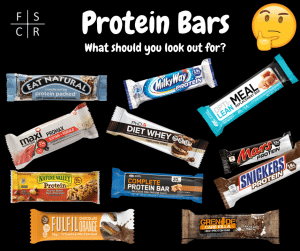You may have guessed – I’m a big fan of protein, and I LOVE a good protein bar to munch on during the day, post-workout, sat on the sofa with a cup of tea, or warmed up with some Greek yogurt. The list on how to enjoy one really is endless. With the rise and popularity of high protein diets in recent years, the protein market has exploded, with protein being added to absolutely everything – bars, bread, pasta and drinks. So, protein bars, what makes them special and are they created equal?
Firstly, just because something contains protein OR has protein in the name, doesn’t mean it’s A) healthy or any better for you than a standard snack bar and B) it’s worth the calories or price-tag. Secondly, I really advocate this, we, and I say we because I am just as guilty sometimes – we shouldn’t be relying on protein bars, shakes etc. to hit our daily protein intake or act as a meal replacement. They should be used as an additional supplement which can aid our goals, particularly if you are rushing and need a healthier snack option or (if like me) you need to be bitch slapped to stop you from eating bars of Cadburys etc.
Total Protein
A lot of so called ‘high protein’ foods actually contain very little protein per serving size, or a minimal amount more compared to the standard product. Perfect example of this is Weetabix and ‘Protein’ Weetabix – normal Weetabix contains 4.6g Protein per serving and ‘Protein’ Weetabix contains 7.6g per serving. Not exactly worthy of the protein title.
As our previous blog post ‘Protein – do we even need it?’ says, Muscle Protein Synthesis (MPS) is optimally stimulated by 20-25g protein every three hours, so it stands to reason if you’re aiming to increase your muscle mass and/or recover post strength training, then choosing a bar which contains 20g protein would be the wisest option. Protein bars which are marketed to athletes do tend to contain 20g or more protein for this exact reason, however, other more commercial ‘protein’ bars often fall short of the optimal. So a question you’ve got to ask is – is it worth the calories if you’re not stimulating the gains? 😉
Carbs & Sugars
Since the protein market has exploded in the last decade, anything which contains protein is perceived to be ‘healthy’ and a better alternative to other snacks found in supermarkets. However, depending upon the ingredients and macro content, some protein bars really aren’t much better than a regular chocolate or cereal bar. And with this I’d like to point out the new Yorkie Protein Crisp Bar. As a massive fan of the Yorkie bar as a child, this seems like heaven, however, with the macros and ingredients of this ‘protein’ bar, I may as well just eat a proper Yorkie.
To make protein bars taste nice and without the added sugar, companies now utilised sugar alcohols or polyols which are sweet yet not fully absorbed by the body and provide a lot less calories per gram compared to sugar. However, as they are still a carbohydrate, they are still listed as a carb on the nutritional information, but underneath sugars it will say polyols. Polyols are safe to eat, however, when consumed in large amounts – more than 15g, these can produce laxative effects and some gastro-intestinal problems. So just be aware of how much you are eating, one bar may be fine, but two might be pushing it.
Protein bars which are made either in America or come from American companies – BPI, Quest, Optimum Nutrition, will display carbohydrates at NET Carbs – essentially what carbohydrates are actually digested by the body. On some UK bars such as Grenade & PhD Smart Bars, these are displayed as Impact Carbs. Many protein bars with low NET or Impact carbs can be effective for those on low carbohydrate diets as they do not affect blood glucose levels the same way as normal sugars – however, the do all still contain calories, and some protein bars can be quite high in calories – particularly when looking at their relative size.
Informed Sport
If you are a professional or sponsored athlete and are governed by UKAD rules and regulations you will need to check if your protein bar is drug tested through Informed Sport. You can check if the bar is tested by looking for the batch number on the Informed Sport website and by checking for the Informed Sport logo on the bar.
My personal favourite is still the Grenade Dark Chocolate Mint, it’s Informed Sport tested, a great texture, and there are loads of delicious flavours. However, the Fulfil Triple Chocolate Deluxe bar and the PhD Diet Whey Salted Caramel are both coming in at a close second, with the only thing letting them down is the slightly hard textures.
So things to look out for:
- Total protein – does it contain 20g protein?
- Carbohydrates – are they impact carbohydrates? Or Sugar Alcohols?
- Sugars – is there a lot of added sugar in there to make it taste better?
- Is it worth the price-tag? Could you get the same benefit from real food?
- Do you need it to be drug tested?


